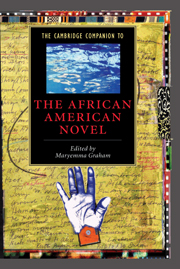Book contents
- Frontmatter
- Introduction
- Part I The long journey
- Part II Search for a form
- 5 The neo-slave narrative
- 6 Coming of age in the African American novel
- 7 The blues novel
- 8 From modernism to postmodernism
- 9 The African American novel and popular culture
- Part III African American voices
- Bibliography
- Index
- Series List
5 - The neo-slave narrative
from Part II - Search for a form
Published online by Cambridge University Press: 28 May 2006
- Frontmatter
- Introduction
- Part I The long journey
- Part II Search for a form
- 5 The neo-slave narrative
- 6 Coming of age in the African American novel
- 7 The blues novel
- 8 From modernism to postmodernism
- 9 The African American novel and popular culture
- Part III African American voices
- Bibliography
- Index
- Series List
Summary
The publication of Margaret Walker's Jubilee in 1966 defined a subject of representation that would come to predominate in the African American novel for the rest of the twentieth century. Literally dozens of novels about slaves and slavery appeared in the wake of Jubilee. Although it would take five more years for the second novel in this tradition to appear (Ernest Gaines's The Autobiography of Miss Jane Pittman), and four more for the third (Gayl Jones's Corregidora), an African American novel about slavery would become almost annual fare thereafter. Given the paucity of novels about slavery before Jubilee and the enduring pervasiveness since, it is natural to inquire about the reasons for this development. What historical or social or cultural events permitted and sustained this new impetus in African American fiction? Since these contemporary narratives of slavery are both formally diverse and yet intellectually indebted to the first form of representation for people of African descent in the New World, the slave narrative itself, it is also worth asking questions about the formal features of this body of work.
- Type
- Chapter
- Information
- The Cambridge Companion to the African American Novel , pp. 87 - 105Publisher: Cambridge University PressPrint publication year: 2004
- 3
- Cited by



